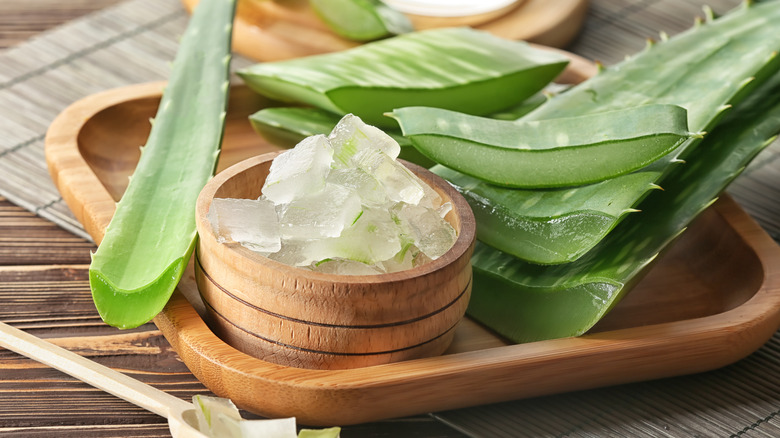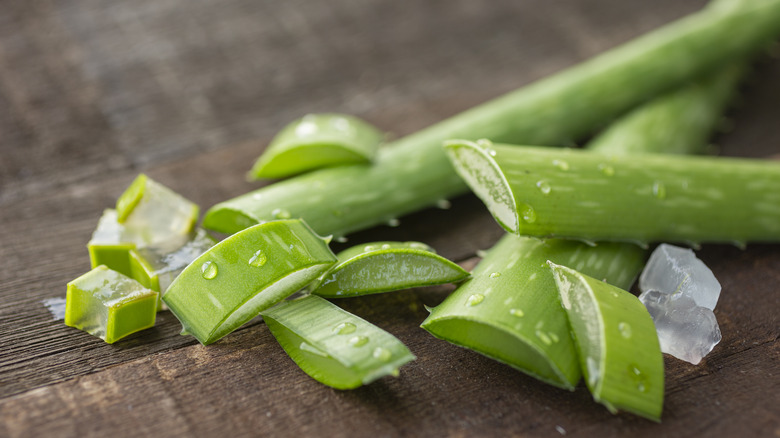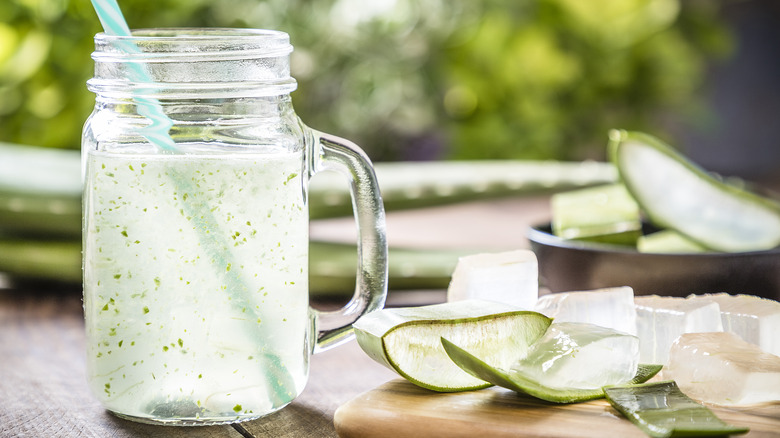Can You Actually Eat Aloe Vera?
The translucent gel packed inside aloe vera leaves has been used for centuries across Egypt, India, China, Japan, Greece, and Mexico for its medicinal and dermal properties. Dubbed the plant of immortality by ancient Egyptians, aloe vera was among the many edible salves that queens like Cleopatra and Nefertiti owed their legendary beauty to. So considering its many benefits, it only seems fair to wonder whether you could eat aloe vera and make the most of its goodness that way too. As it turns out, both the skin and the gel of aloe vera leaves are safe to eat, as long as you pick the right plant and prep it properly.
Aloe vera is one of over 400 species of aloe that belong to the Asphodelaceae family of plants, and not all of them are edible. The type of aloe that you can eat is known as Aloe vera barbadensis Miller, which is characterized by its wide and spot-free greyish-green leaves and yellow flowers. Aloe vera var. chinensis, on the other hand, whose bluish-green leaves are narrow, flecked with spots, and dotted with orange flowers, is not meant to be eaten. That said, even the edible aloe vera has its side effects, though as long as you know when and how much of it to eat, the green leaves can be perfectly safe for consumption.
Benefits and side effects of eating aloe vera
Aloe vera's dermal benefits are fairly well known: When applied on the skin, its cool gel can soothe sunburn and inflammation, heal minor first and second-degree burns, and have a calming effect on itchy and irritated skin. But eating aloe vera has its own set of benefits. Consuming aloe vera gel can reduce blood sugar levels and boost metabolism, thereby aiding weight loss (via Healthline). A 2013 study published in Nutritional Neuroscience found that aloe vera helped reduce depression among mice while improving their memory and learning abilities. Plus, a regular diet of aloe vera may help with chronic diseases by raising the level of antioxidants in your blood. Aloe vera has another significant benefit, though the same thing can be its greatest risk under certain conditions.
You'd think that aloe vera has a third component that is sandwiched between its green skin and jelly-like flesh inside: A layer of yellow liquid that has compounds such as aloin which can have a laxative effect. When consumed in small quantities, the laxative properties can be beneficial for digestion and can provide relief from constipation but long-term use or large quantities of it can have grave side effects, including diarrhea, muscle weakness, cramps, and irregular heartbeat. The laxative can also be harmful to anybody who is pregnant or has digestive diseases such as IBD, as well as to those taking diabetes, heart, and kidney medications — it's best to be cautious in such cases.
How to eat aloe vera
Just because you can eat aloe vera doesn't mean that you can buy any over-the-counter tub and dig into it with a spoon. Aloe vera gels meant for the skin are very different from those meant to be consumed because they often contain inedible ingredients. Besides, there are 75 active compounds such as vitamins and fatty acids inside aloe vera, which can all be stripped off when it is processed for skin care. Unless you can find food-grade gels, it's best to either grow and eat your own aloe vera or buy entire leaves from the store.
Once you have the leaves, begin by slicing off the edges that are covered in spikes and then peel away the flat side of the skin. Scoop out the gel, chop it as you'd like, and give it a rinse to wash off the yellow laxative liquid and any dirt that may be present. You can eat the gel as it is, blend it, or cook it — mix it with water to make aloe vera juice, add it to shakes and smoothies, or top it onto stir-fries, and soups. When cooked, aloe vera gel loses some of its water and becomes softer and less slippery, thus making it more appetizing for those who don't care much for its texture. As for the skins, their crunchy texture may be a welcome addition to salads. You can even get creative and use them as chips for dips and sauces!



